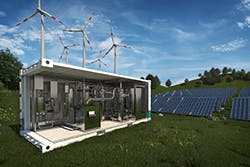Clariant Promotes Renewable Energy Through German Kopernikus Initiative
Liquid Organic Hydrogen Carriers (LOHC) technology to store hydrogen produced from renewable energies
Clariant’s Catalysts business is participating in the Kopernikus technology initiative of the German Federal Ministry of Education and Research. The aim of the major cross-industry program is to promote the switch to renewable energy. Of the four main Kopernikus projects, Clariant is contributing to the “Power-to-X” project by designing catalysts tailored for the LOHC (liquid organic hydrogen carriers) technology.Clariant’s partners in the LOHC development team include:
- RWTH Aachen University
- Forschungszentrum Jülich (FZJ)
- Friedrich-Alexander University Erlangen/Nuremberg (FAU)
- Karlsruhe Institute of Technology (KIT)
- Fraunhofer Institute for Mechanics of Materials (IWM) / Fraunhofer Institute for Solar Energy Systems (ISE)
- Leibniz-Forschungsverbund Energiewende (WZB/DIW)
- Areva H2Gen GmbH
- Hydrogenious Technologies GmbH
- thyssenkrupp Industrial Solutions AG
In a method developed by Hydrogenious Technologies, hydrogen is chemically bound to the LOHC carrier, which acts like a battery for hydrogen: it charges through catalytic hydrogenation and releases hydrogen via catalytic dehydrogenation. Compared to conventional methods, the LOHC concept reportedly enables significantly safer and more efficient storage and transportation of hydrogen. Among other benefits, this will facilitate the conservation of surplus energy from wind and solar sources. Clariant has successfully developed dedicated catalysts for LOHC hydrogenation (EleMax H 101) and dehydrogenation (EleMax D 101), according to the company.
Under the Kopernikus “Power-to-X” project, the LOHC research phase is sponsored for an initial period of three years. During this time, the team intends to advance LOHC technology from research and development to industrial maturity.
For more information, visit: www.clariant.com

